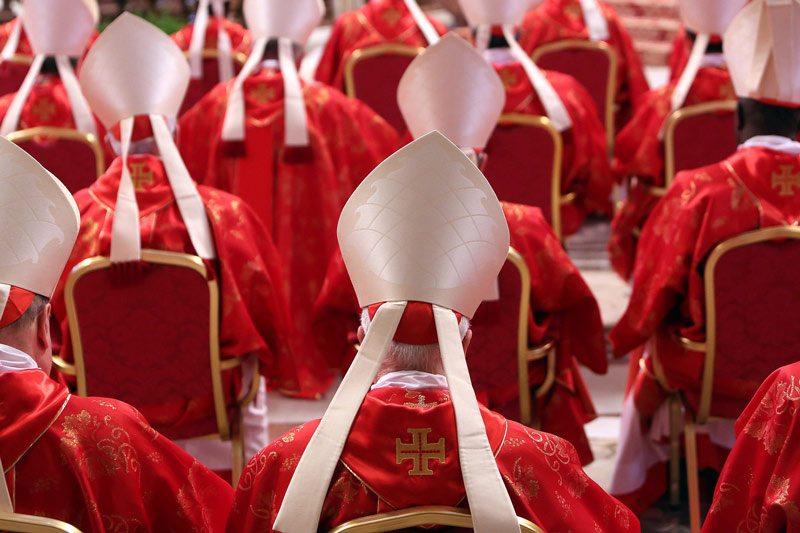
Definition & Explanation:
Cardinal comes from the Latin word meaning “hinge”. A cardinal is a dignitary of the Roman Catholic Church and counselor of the pope.*
Relations of the cardinals to the bishops
The cardinals were, therefore, from a very early period, assistants of the pope in his liturgical functions, in the care of the poor, the administration of papal finances and possessions, and the synodal disposition of important matters. They took on a very much greater importance, however, after the decree of Nicholas II (1059), “In nomine Domini”, regulating papal elections. In accordance with this document the election of the pope and the government of the Church, during the vacancy of the Apostolic See, fell more and more into their hands; they passed to them exclusively after the Decretal of Alexander III, “Licet de vitandâ”, at the third Lateran Council (1179). We may add to this that after the cessation of papal journeys to the different nations of Christendom and of the Roman synods under papal presidency, the cardinals remained almost the only counsellors and legates of the popes.
The place and the occasion of this manifold activity of the cardinals was the consistory, i.e. the reunion of the cardinals and the pope. In it were regularly treated questions of faith and important disciplinary matters, e.g. dogmatic decisions, canonizations, approbations of rules of new orders, affairs of the Inquisition and the universities, indulgences for the Universal Church, modifications of the rules for papal elections, the convocation of general councils, also the nomination and mission of Apostolic legates and vicars. Moreover, in the consistory were treated all matters concerning dioceses and bishops, the so-called causæ majores par excellence, among them the creation, transfer, division, reunion, and suppression of dioceses, the nomination and confirmation of bishops, also their transfer, resignation, cession, suspension, deposition, and degradation.
Given the position of the pope and his intimate relations both to the individual cardinals and to such a close corporation as the college itself, at papal functions, in papal elections, in synods, in the consistory, in the conduct of diplomatic negotiations, it is easy to understand how all cardinals, including cardinal-priests and cardinal-deacons came to outrank bishops and archbishops, and after the fourteenth century even patriarchs, just as at Constantinople the syncelli eventually outranked bishops and archbishops. This pre-eminence, however, was a matter of slow and uneven development. The cardinal-bishops were the first to outrank other bishops, then archbishops, and finally patriarchs. But as the cardinals formed a college, and the collegiate rights were equally shared by all, the cardinal-priests and cardinal-deacons claimed the same rank as the cardinal-bishops, while the latter were quite willing to see their colleagues placed on their own higher plane.
There were never any “cardinals by birth” (cardinales nati), i.e., no other office necessarily implied elevation to the dignity of cardinal.
Relations of the cardinals to the pope
In the Middle Ages the cardinals attempted more than once to secure over the pope the same pre-eminence which they had secured in a permanent way over the episcopate, i.e., they sought to change the monarchical form of government into an aristocracy. The Council of Basle decreed that it was the duty of the cardinals, first individually and then as a college, to reprove any pope forgetful of his duty, or acting in a way that no longer corresponded to his exalted position (Hardouin Acta Conc., VIII, 1208).
Nomination of the cardinals
In the nomination of cardinals the pope has always been, and is still, free.
According to the demand of the reform-councils there should be in the college representatives of all Christian nations. Sixtus V decreed, in keeping with the wishes of the reform-councils, that, above all, it should contain doctors of theology, and that there should be in the college at least four theologians from the mendicant orders. According to an ancient concession the wishes of Austria, Spain, and Portugal are as far as possible respected, when there is question of raising to the cardinalate a bishop of one of these nations, known thenceforth as a crown-cardinal. It is customary for the governments of the same nations to contribute at the creation of such a cardinal the incident “taxes” or expenses ($3000). Similarly they are wont to provide for the support of their respective national cardinal protectors. At the Vatican Council the demand was made that in the Sacred College and the Roman Congregations there should be from every nation not only scholarly, but also wise and experienced, men. The person nominated must possess the qualifications of a bishop. He must, therefore, be at least thirty years of age.
In keeping with the provisions for promotion to nobility, illegitimates, even when legitimated by later marriage, are ineligible the fathers of (living) legitimate children, nephews or cardinals, and those who are related to a cardinal in the first or second degree of consanguinity. Of course, the pope can occasionally dispense from these disqualifying conditions.
The nomination of cardinals takes place in a secret consistory, during which those actually resident in Rome are informed of their nomination. In the afternoon of the same day the newly-created cardinals meet in the pope’s apartments, in the antechamber of which the scarlet zucchetta, or skull-cap, is handed to them; thereafter the scarlet biretta is placed by the pope on the head of each.
The “red hat” is given in the next public consistory after they have taken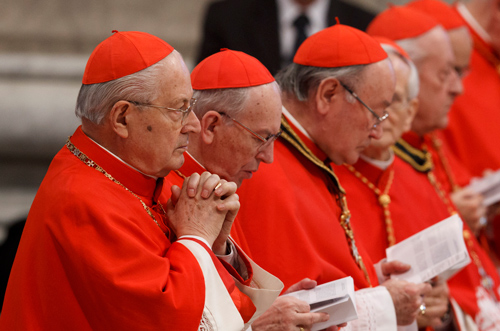 the customary oath. At the beginning of the next secret consistory takes place the ceremony known as the “opening of the mouth” , and at the close of the same consistory the “closing of the mouth”, symbolizing their duties to keep the secrets of their office and to give wise counsel to the pope.
the customary oath. At the beginning of the next secret consistory takes place the ceremony known as the “opening of the mouth” , and at the close of the same consistory the “closing of the mouth”, symbolizing their duties to keep the secrets of their office and to give wise counsel to the pope.
The ring is then given to each, and at the same time the “title” or church by which the new cardinal shall henceforth be known.
Formerly the dignity of cardinal was acquired only after public proclamation and reception of the hat and ring. At present any form of publication suffices. From the reign of Martin V, i.e. from the end of the Western Schism, during which there were many cardinals created by the contending popes, it became customary for the pope to create cardinals without declaring their names (creati et reservati in pectore), the Italian equivalent for which is in petto. The publication of the names may, in given circumstances, be made at a much later date.
The oath taken by the cardinals is quite similar to that taken by bishops. But the cardinal must swear that he will defend conscientiously the papal Bulls concerning non-alienation of the possessions of the Roman Church, nepotism, and papal elections, likewise his own cardinalitial dignity.
Duties of cardinals
It is the duty of the cardinals to assist the pope at the chief liturgical services known as capellæ papales, to distinguish them from the capellæ cardinaliciæ, at which the pope is not present; also to counsel him and aid in the government of the Church. Hence the cardinals are obliged to reside at Rome and cannot leave the Papal States without permission of the pope. The violation of this law entails grave penalties, even the loss of the cardinalitial dignity.
It is otherwise with foreign bishops created cardinals; they retain their dioceses and are not obliged to reside at Rome. The “suburbicarian” bishops, however, by ancient custom reside at Rome. The share of the cardinals in the government of the Church is exercised partly in the consistories, partly in the curial offices in the Roman Congregations, and in various ecclesiastical commissions.
The Consistory
A papal consistory is the assembly of the cardinals about the pope and recalls the consistorium principis of the Roman Empire. Consistories are public or extraordinary, and secret or ordinary. Semi-public consistories are a combination of a public and a secret consistory. The public consistories are attended not only by the cardinals, but by the bishops, prelates, princes, and ambassadors to the papal court present in Rome. They are called for the purpose of giving the red hat to new cardinals, the solemn conclusion of canonizations, and public audiences to sovereigns and their ambassadors. Much more important are the secret consistories. With the transfer of their judicial attributes to the great curial offices, especially the Rota and the Roman Congregations, consistories became less frequent. Secret consistories are now called more rarely, at intervals of several months, and deal with the few subjects or questions actually pending.
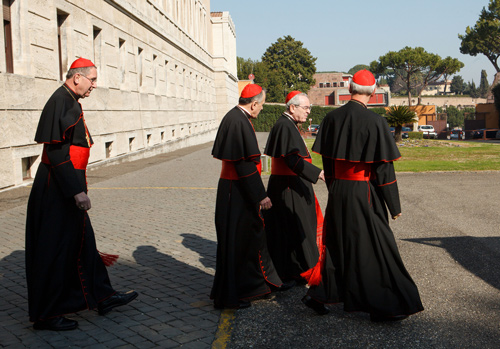 The following matters are dealt with in them, and call for the counsel of the cardinals: the creation, i.e. nomination proper, of new cardinals; the publication of names reserved in petto; the giving of the cardinalitial insignia with exception of the red hat; the opening and closing of the mouth; the institution of patriarchs, metropolitans, and bishops, and the nomination of such titular bishops as do not belong to the missionary territories; the transfer of bishops; the granting of the pallium to archbishops; the creation, division, and union of dioceses; the institution of abbots whose abbeys are in the gift of the Holy See; the nomination of the camerlengo and the vice-chancellor of the Roman Church; the choice and mission of cardinals as legati a latere; the conclusion of concordats, consultation on differences and conflicts between Church and State. Generally, however, the consistory is called only to inform the cardinals by a so-called allocution of the status of important ecclesiastico-political matters, or to make known the opinion of the pope.
The following matters are dealt with in them, and call for the counsel of the cardinals: the creation, i.e. nomination proper, of new cardinals; the publication of names reserved in petto; the giving of the cardinalitial insignia with exception of the red hat; the opening and closing of the mouth; the institution of patriarchs, metropolitans, and bishops, and the nomination of such titular bishops as do not belong to the missionary territories; the transfer of bishops; the granting of the pallium to archbishops; the creation, division, and union of dioceses; the institution of abbots whose abbeys are in the gift of the Holy See; the nomination of the camerlengo and the vice-chancellor of the Roman Church; the choice and mission of cardinals as legati a latere; the conclusion of concordats, consultation on differences and conflicts between Church and State. Generally, however, the consistory is called only to inform the cardinals by a so-called allocution of the status of important ecclesiastico-political matters, or to make known the opinion of the pope.
After the death of the pope (sede vacante) the duties of the College of Cardinals differ from those exercised by them during his lifetime. The pope, before death, commands the cardinals to make all due haste with the election and to concern themselves with nothing else, except in case of necessity, e.g. the defense of the States of the Church or any part of them, or some danger so great and evident that each and every one of the cardinals present thinks it necessary to deal with it immediately.
The law prevailing at present is based on the Constitution “In eligendis” of Pius IV (9 October, 1562). This constitution provides that according to ancient custom the administration of the States of the Church shall be confided to the College of Cardinals after the following manner: the cardinal camerlengo and three other cardinals shall manage all current business. These cardinals do not possess papal jurisdiction; they cannot therefore make laws nor modify the system of papal elections, create cardinals or bishops, nor issue commissions to cardinal legates. They could, however, in case of a grave danger menacing the Church, provide by an absolute majority and secret vote for the necessary ways and means to meet the situation, issue urgent temporary ordinances for particular dioceses, and order the public recitation of prayers. No canonical provisions exist regulating the authority of the College of Cardinals in case the pope became insane, or personally a heretic; in such cases it would be necessary to consult the dictates of right reason and the teachings of history.
Rights of cardinals
To the many duties of the cardinals correspond very extensive rights. They enjoy, in a very special manner, the right to ecclesiastical court and judges; the pope is their only judge, and alone can depose them. The provision that for the condemnation of an ecclesiastic seventy-two, forty-four, or twenty-seven witnesses were needed, according as he was bishop, priest, or deacon, is no longer recognized. Modern states no longer recognize the privilegium fori even for cardinals; in recent times they have often appeared before the civil courts at Rome. Inimical persecution of a cardinal, personal injury to, or imprisonment of, him, are counted high treason; not only the principals, but also those intellectually responsible for the wrong (originators, participants, auxiliaries), and their male descendants incur the canonical penalties of infamy, confiscation, loss of testamentary rights and civil offices, and excommunication. Apart from excommunication these penalties are no longer practically applicable.
In accordance with the historical development of the office, the cardinals obtained place and vote in general councils. They alone can be sent abroad as legati a latere. They enjoy all the privileges of bishops. Any censure, canonical, or otherwise threatened, or any odious provision is applicable to cardinals only when it is expressly so provided. They may choose a confessor in any diocese; he must, however, have the approbation of his own bishop. Like the bishops, they have the right to a domestic chapel, and may everywhere use portable altars. In their titular churches the cardinals exercise a certain quasi-episcopal jurisdiction, i.e. they may there use the episcopal ornaments (pontificalia), give the episcopal blessing, and promulgate indulgences of 200 days. When actually present in Rome, they may grant benefices in their titular churches. They may also hold visitations in their own churches, and exercise therein corrective and disciplinary authority; they may not, however, exercise judicial authority.
If a cardinal is promoted to a bishopric, the usual informational process is omitted; he is not obliged to take the usual oath, and is relieved of the ordinary curial expense known as tax. Every cardinal resident in Rome has a right to a revenue of 4,000 scudi (about $4,000). This is known as his piatto cardinalicio, or ordinary means of support. If the ordinary revenues assigned him do not produce as much, the papal treasury makes up the deficit. For their support churches are also assigned to them, e.g. as commendatory abbots. Their right to elect the pope will be treated in the article on a conclave.
The honorary rights of the cardinals are also numerous. 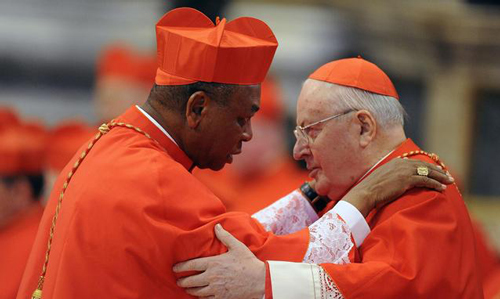 They come immediately after the pope, and precede all other ecclesiastical dignitaries. As Roman princes they follow immediately the reigning sovereign, and rank with the prince of reigning houses. Hence, only cardinals of reigning houses retain their inherited titles of nobility and their family arms, but without the crown and with the cardinal’s hat and the fifteen tassels. They alone have the right to the name of cardinal and are addressed as Eminentia, (Your Eminence). Urban VIII instructed them (10 June, 1630) to cease correspondence with any sovereign who refused them this title. It may be added that the legislation of several states takes cognizance of the exalted rank of the cardinals.
They come immediately after the pope, and precede all other ecclesiastical dignitaries. As Roman princes they follow immediately the reigning sovereign, and rank with the prince of reigning houses. Hence, only cardinals of reigning houses retain their inherited titles of nobility and their family arms, but without the crown and with the cardinal’s hat and the fifteen tassels. They alone have the right to the name of cardinal and are addressed as Eminentia, (Your Eminence). Urban VIII instructed them (10 June, 1630) to cease correspondence with any sovereign who refused them this title. It may be added that the legislation of several states takes cognizance of the exalted rank of the cardinals.
Chief among the insignia of the cardinal is the red hat, first worn by the legati a latere (cardinal envoys of the pope). It was granted to the secular cardinals by Innocent IV at the Synod of Lyons in 1245, and to the religious cardinals by Gregory XIV in 1591; the latter, it must be noted, continue to wear the distinctive habit of their order. They also wear the red (scarlet) biretta, that was granted to them. They also have the right to wear scarlet, particularly a scarlet mantle, which according to tradition was probably granted them. They also wear a ring with a sapphire stone, and use the ombrellino that is held over them whenever they quit their carriages to accompany with bare heads the Blessed Sacrament, if perchance they meet It on their way. In their titular churches a baldacchino covers the cardinalitial throne, and they have the right to use in these churches the episcopal ornaments, i.e. the mitre of damask silk, the crosier and the pectoral cross. They also give the benedictio sollemnis after the manner of a bishop. Pius X permitted cardinal-priests and cardinal-deacons to wear everywhere the pectoral cross, even in presence of the pope. During the vacancy of the Apostolic See the colour of the cardinal’s dress is saffron.
The college of cardinals
The cardinals, as already said, are a corporation, a college after the manner of the cathedral chapters. When the latter ceased to lead any longer the common life, they became corporations recognized by the canon law, with free administration of their property, chapter-meetings, autonomy, disciplinary authority, and the right to have and use a seal. They alone had the right to elect the pope, they alone were his immediate assistants at Mass, and were his only counselors in all important matters.
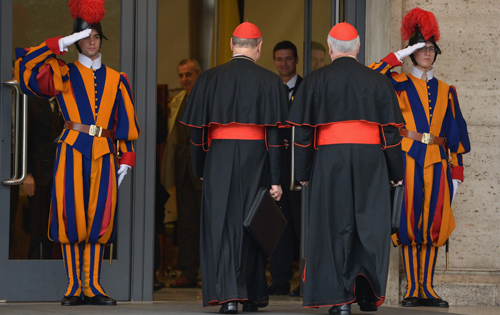 Since 1150 the corporation of the cardinals becomes more and more known as a college. The dean or head of the College of Cardinals is the Bishop of Ostia. During a vacancy, when later the cardinals became a corporation that included bishops among its members, one of these bishops must naturally assume the headship; it could be no other than the Bishop of Ostia, whose immemorial right it was to bear the pallium at the consecration of the newly-elected pope, in case the latter were not yet a bishop, and of taking in general councils the first place after the pope. As president of the college it is the duty of the dean to convoke the same, to conduct its deliberations, and to represent it abroad.
Since 1150 the corporation of the cardinals becomes more and more known as a college. The dean or head of the College of Cardinals is the Bishop of Ostia. During a vacancy, when later the cardinals became a corporation that included bishops among its members, one of these bishops must naturally assume the headship; it could be no other than the Bishop of Ostia, whose immemorial right it was to bear the pallium at the consecration of the newly-elected pope, in case the latter were not yet a bishop, and of taking in general councils the first place after the pope. As president of the college it is the duty of the dean to convoke the same, to conduct its deliberations, and to represent it abroad.
As a legal corporation the cardinals have their own revenues, which are administered by a camerlengo. In the Middle Ages the revenues of the College of cardinals were considerable. The common revenue of the College of Cardinals is now inconsiderable; hence the dividend paid yearly to the cardinals resident in Rome, is comparatively small.
Precedence or rank among the cardinals is regulated according to the three orders above described, and in each order according to seniority. In the order of bishops, however, seniority is not according to date of reception in the cardinalitial body, but according to the date of episcopal consecration. This means that when a cardinalitial office is vacant, the cardinal next in rank of seniority can choose the vacant office. Thus the oldest of the cardinal-bishops can choose the office of Dean of the College; he becomes at the same time Bishop of Ostia, since according to ancient custom the Dean of the Sacred College is always the Bishop of Ostia. However, in the interest of their dioceses, and apart from the bishoprics of Ostia and Porto, the cardinal-bishops are allowed to make such option but once.
This article in its entirety can be read by clicking here.
*(newadvent.org, credit below, original has been edited and shortened)
APA citation. Sägmüller, J.B. (1908). Cardinal. In The Catholic Encyclopedia. New York: Robert Appleton Company. Retrieved January 6, 2015 from New Advent: http://www.newadvent.org/cathen/03333b.htm



